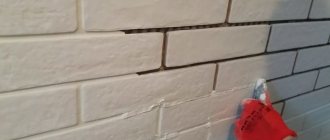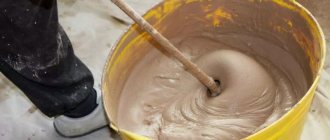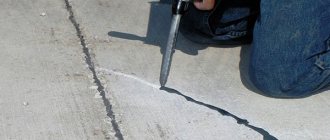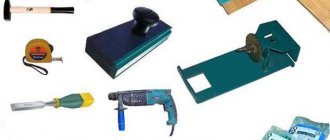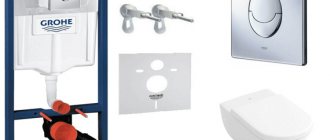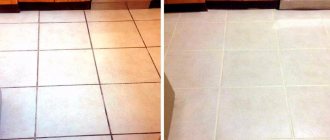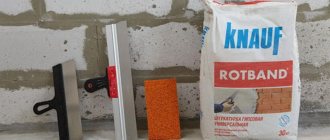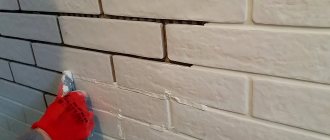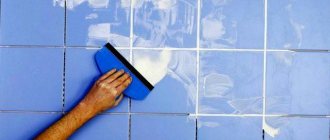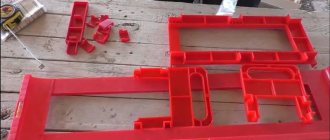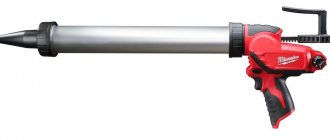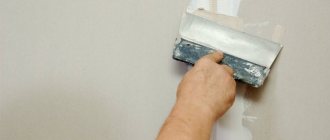Brickwork is a trend that never goes out of date. Brick is used both as the main material for the construction of walls and for decorative cladding of facades. Recently, brickwork has begun to be left inside rooms, creating so-called “loft” interiors.
Of course, in such cases, quite high requirements are applied to the quality of the masonry. The wall should look aesthetically pleasing and neat, because it is, so to speak, the front side. The mortar that hardens in the brick joints usually does not look the best. And to give the masonry an attractive look, you need to work with it. To make the wall look beautiful and noble, the brickwork is jointed. We will talk about what types of jointing there are and how to do it correctly in this publication.
Required Tools
Seam jointing can be of several types, each of which requires its own tool, called jointing. This tool can be found on any construction market or made independently.
Flat types of joints are intended for cutting a seam with one or two cuts, as well as for direct penetration. You can get a concave seam shape with two cuts using the pointed end of the tool. To give a concave shape, improvised means and tools are sometimes used.
For example, a metal pipe whose diameter is either equal to the thickness of the seam or slightly exceeds it. Concave jointing is done using any rounded object, for example, a trowel.
Step-by-step instruction
For correct jointing you need to follow the following steps:
- Remove excess mortar from the seam.
- Apply pre-prepared grout solution.
- Remove excess mortar using a trowel.
- Make a joint.
After removing a small amount of cement mortar (to a depth of no more than 6 mm), the jointing mixture is applied. It should be applied with a slight excess. Then take a trowel and remove the excess mixture. After this comes the most crucial moment: It is necessary to stitch along the vertical seams. The work is carried out quickly by pressing the tool into the seams.
Pressing helps get rid of any air that has formed under the solution. If you do not get rid of it, the strength characteristics of the brickwork will decrease and it may subsequently crumble.
After processing the vertical seams, you can begin to join the horizontal ones. For these purposes, it is convenient to use long jointing.
To get the desired shape of the seam, you can use the means at hand:
- A wooden stick with a sharpened end will help you create a seam with beveled edges.
- A plastic tube is suitable for creating a concave seam.
- A wooden plank will help make a recessed rectangular shape.
After giving the desired shape, the brickwork can be left to dry.
When processing seams, it is not recommended to work on a very hot or rainy day.
High temperatures will cause the mixture to dry out quickly. In addition, the mixed solution will need to be prepared more often. And on a rainy day, the mixture can absorb excess moisture.
To confidently process the seams of brickwork with your own hands, you can watch the video instructions, which contain step-by-step jointing.
You can also paint the masonry to give it an aesthetic appearance. How to paint a brick wall, read this article.
Solution: details of preparation and use
The composition and quality of the cement mortar largely determine the service life and strength qualities of the structure as a whole. Cement, lime and combined materials can be used as a binder. The most popular and in demand are solutions based on a cement-sand mixture, which is due to the high strength of the frozen mixture and its resistance to adverse environmental factors. Disadvantages include the relatively high cost and limited plasticity of the solution, which is of particular importance when opening joints.
The plastic properties of cement-sand mortar can be increased using chemical additives and plasticizers. A plasticizer is a surfactant that retains moisture and prevents the rapid hardening of the building mixture, making it easier to process.
The modern construction market offers a wide range of plasticizing additives from imported and domestic manufacturers. Some brands of such substances not only increase the plasticity of the building mixture, but also have a positive effect on the strength of the hardened mixture.
When choosing a building mixture, you should proceed from the following features of the future building:
- Purpose of the building;
- Climatic conditions;
- Temperature conditions inside the building;
- Humidity levels inside and outside the building;
- Vertical size of masonry;
- The built-in strength of the walls.
An important point: remember that inclusions of dust, clay or mica in the sand, which is used to make mortar, reduce its strength properties. Also, the presence of such impurities in sand negatively affects the solution’s resistance to low temperatures.
For the construction of low-rise buildings and structures, it is recommended to use mortars of grade 25 and higher. For rooms with high humidity, the cement mortar must be at least grade 50. The proportions of the building mixture may vary depending on the components used. So, for example, to make a cement-sand mixture of grade 50 using lime as a plasticizer, the following proportions must be observed: 6 * 1 * 0.7 for sand, M300 cement and lime, respectively.
It should be noted that two methods of marking cement mixtures are currently used: the M300 brand corresponds to CEM-22.5, and M400 corresponds to CEM-32.5.
Cleaning masonry
Before repairing the masonry, after removing the old bricks, they begin to get rid of efflorescence, fungal infections, and graffiti. The repair estimate depends significantly on the chosen method of performing this procedure.
1. Mechanical. The most labor-intensive method, it is carried out using hard brushes, wooden scrapers or an angle grinder (grinder) with cleaning discs. When cleaning with a brush, due to the use of manual labor, the cost of performing the work increases; the process itself is time-consuming and does not guarantee a good result.
2. Washing. Water with added detergent removes minor stains. When carrying out the procedure, it is necessary to ensure that moisture does not get deep into the seams and does not corrode them.
3. Hydrojet. Occurs due to the impact on contaminants of a powerful jet of water from a hydro-jet apparatus with a high-pressure pump.
4. Chemical. To more effectively clean bricks from efflorescence and other contaminants, various special products are used - liquid or paste. The disadvantage is that it significantly increases the cost of restoration. Stains of tar, oils, and bitumen are removed using conventional organic solvents: white spirit, kerosene, turpentine.
5. Sandblasting. The compressor delivers a special type of sand to the wall with a strong stream of compressed air. There are four methods: classic, wet - for very dirty surfaces, with ice - to remove dirt from even the smallest cracks, fire - to clean walls heavily overgrown with moss or mold. Disadvantages - the surface is often damaged, chipping may occur; visibility during work is very poor; personal protective equipment against dust clouds is required; high consumption of sand.
6. Soft blasting. This is a type of abrasive blasting technology, which also includes sandblasting, but soft materials are used instead of sand. The main advantages are that visibility is not reduced, which allows you to control the process; the surface is not damaged due to the use of low-abrasive compounds; safety for humans and the environment.
7. Dust-free blasting with water. It is characterized by a complete absence of dust; after completion there is no dirt or waste left.
Restoration work also includes artificial aging of bricks. It is performed using soft blasting or without dust with water. Rates per square meter are the same as for cleaning. The surface of the masonry is made uneven, visually increasing its age. This effect is used to create a fashionable loft style in the interior and facade design of a house. Including such processing in the estimate does not significantly affect the final cost of repairs.
The choice of method depends on the type of prevailing contaminants. For example:
- stains from oils and soot, remnants of masonry mortar, old paint, mold - sandblasting;
- graffiti, paint, rust - soft blasting, sandblasting;
- plaster - before restoring a plastered wall, the old coating is removed mechanically with a chisel and hammer, then wiped with a stiff brush and the remaining dirt is washed off with a wet rag;
- efflorescence - metal brush and water;
- moss - any mechanical or abrasive blasting method.
Convex jointing
This type of seam processing is widely used in modern construction. The mortar protrudes beyond the plane of the brickwork. It should be noted that the strength of the mortar is less than that of brick, and therefore you should avoid leaving the plane of the masonry by more than 3 mm.
Joining with one cut using flat tools. The solution is cut to a depth of 3-4 mm from the plane of the wall. In this case, you should follow the technology for performing the work, since moisture can accumulate in the space freed from the solution.
Methods for cutting seams of T-welded joints
As you can see, the parts have a position that resembles the letter “T”, hence referred to as a T-joint, in which one part is perpendicular to the second. Thus, the surface of the edge of one part is connected by welding to the flat surface of the second. Accordingly, only one part can be processed by cutting, as in the figure below.
The connection without cutting is welded on both sides and is used for parts of the same metal thickness, not exceeding 10 mm. No special processing of the edge of the perpendicularly located part is used, only grinding, if necessary, to ensure a tight fit of the edge to the plane (up to 2 mm gap). It is important to take into account that welding T-joints without groove is different if the perpendicularly located (vertically standing) part has a smaller thickness than the second, horizontally adjacent one. The electrode is simply placed at an angle of 60 degrees to the thicker part, which promotes greater melting.
A connection with a groove is performed if a particularly strong seam is required and the T-weld joint has a perpendicularly placed (vertically standing) part, the metal thickness of which is greater than 10 mm (at least 8 mm). This can be either one-sided or two-sided cutting, with the edge being cut straight, at an angle of 45 degrees. Thus, welding of large thickness parts occurs in several layers until the entire cutting space is filled.
Laying bricks with jointing
When erecting walls and other structures made of bricks, the direction of the masonry seams must be clear. Only in this way can a uniform load on the foundation be achieved and the durability and stability of the structure be ensured.
The algorithm for laying bricks with jointing is as follows:
- Setting levels (orders and berths);
- Distribution of material along the wall;
- Laying the mortar under the outer mile;
- Laying the outer mile with trimming excess mortar;
- Spread the mortar under the inner mile;
- Laying the inner mile;
- Laying the solution under the forgettable;
- Checking the masonry;
- Unstitching.
Work should be performed strictly in the given sequence. Horizontal seams are sealed only after the vertical ones are sealed. The thickness of the horizontal layer should be about 12 mm, and the vertical layer - 10. In some cases, seams with a thickness of 8 to 15 mm are acceptable.
Joining work must be completed before the mortar begins to set. The mixture that has lost its elasticity prevents the sealing of the seam and negatively affects the performance properties of the masonry as a whole.
An important point: fresh masonry must be protected from direct contact with water. This can be done using special waterproofing materials. If this is not done, the mortar in the joints may wash away.
Safety precautions
You should not grout in hot weather, because the mortar mixture dries out much faster. Craftsmen recommend waiting out rainy weather so that the solution does not absorb a lot of moisture.
Carrying out such work requires the use of protective equipment - helmet, goggles, gloves, overalls and a respirator. Before working on scaffolding, you should study the safety requirements for high-rise repairs.
It is prohibited to hang yourself on a wall or lean on freshly laid brickwork, work on random supports, or leave tools unattended.
Precautionary measures
When performing jointing work, you must follow the safety rules:
- use personal protective equipment: helmet, safety glasses or face shield, gloves, thick clothing, shoes with steel toe caps and thick soles, respirator;
- follow the rules for working at height;
- do not hang on the wall or lean on fresh masonry;
- do not work from random supports, use only scaffolding, stepladders and scaffolding;
- do not leave tools and materials on scaffolding unattended;
- Before using electrical appliances, make sure they are in good working order and that their insulation is intact.
To unstitch the seams, you will need personal protective equipment.
Compliance with these requirements will save your health and life.
